According to the norms, any open areas - a terrace, a porch, a balcony, as well as all flights of stairs with more than 3 steps - need a fence. This design prevents falls from a platform or staircase and makes it easier to climb. The device of the fence is determined by the norms of SNiP.
- The main functions of the terrace fence
- Fencing options by type
- Open
- Closed
- Fencing options by material
- Wood-polymer composite
- PVC
- Wrought iron
- Made of metal
- From glass
- Of stone
- Cellular polycarbonate or monolithic
- From ropes or ropes
- Made of wood
- Options by type of execution
- Horizontal
- Vertical
- Crossover
- Screen
- DIY terrace fences
- Maintenance of terrace fences
The main functions of the terrace fence
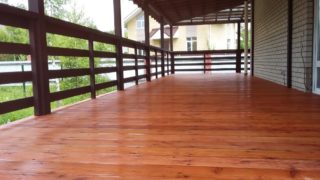
The terrace fencing consists of balusters, railings and internal filling. You can do without the last element if you install vertical posts often enough. Safety requirements for terraced structures are higher than for staircases.
The fence has several functions:
- Protective - the barrier prevents animals from entering the territory of the house or prevents the opposite - the escape of pets. Also, the fence does not allow young children to leave the site on their own, putting themselves in danger.
- Dividing - even a symbolic option creates a sense of security by restricting access to the terrace.
- Decorative - the design can serve as a real decoration, since any of the elements can be very attractive and interesting.
Fences can be temporary or permanent. The first option is put, for example, in summer cottages, when the summer season begins.
Fencing options by type
There are several options for terrace or veranda railings made of wood. The design is selected in accordance with the level of the site, the style of the building, and safety requirements. By design features, there are 2 types of structures: open and closed.
Open
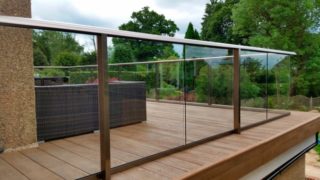
There is no filling in such a model. The railing includes vertical elements (posts) or vertical and horizontal parts. The frequency of placement of strips and rails is determined by SNiP. If the railing includes only vertical posts, the latter are installed at a distance of no more than 10 cm from each other. If there are transverse bars, the distance between the supports is greater, and the horizontal elements are placed so that when they cross, a cavity does not form through which a ball with a diameter of 107 mm can be squeezed.
Closed
Includes content. These are screen, combined barriers, in which the space between the racks is completely covered with sheet (polycarbonate, glass, metal) or lath materials. Boards, planks are placed almost close to each other.
Closed structures are safer, but they are more expensive, since they are more material-intensive.
Fencing options by material
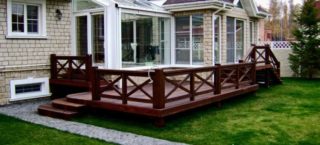
Fences are made from a variety of materials. This variety is due to the nature of the design. The temporary fence is made easier, since it needs to be rearranged from place to place and disassembled. Stationary structures are made of materials that are more durable and reliable.
Wood-polymer composite
Modern and highly technical material. Consists of polymer resins and sawdust.The first component provides complete insensitivity to moisture, water and sun. The second guarantees resistance to cold, good appearance and ease of processing.
WPC veranda fencing is the best option. The composite perfectly imitates wood, but at the same time it lasts much longer.
PVC

Polymeric material with all its inherent disadvantages and advantages. The disadvantages include low resistance to ultraviolet radiation (the material turns yellow) and instability to heat. The pluses are lightness, design plasticity, cheapness and insensitivity to water.
PVC products are cast, not cut. This method allows you to make fences of a very complex original shape.
Wrought iron
One of the most beautiful models, but also the most expensive. The grating for the terrace is made standard, and the decorations are forged from iron, cast iron, bronze, brass. There are completely forged options - they are extremely expensive.
In addition to exceptional beauty, forged structures are durable, very strong, and are not afraid of cold, snow or rain.
Made of metal
Round and shaped pipes made of stainless steel or black chrome-plated steel can also serve as the basis for a fence. Quite complex and beautiful designs are obtained by stamping or casting. Metal fences can be painted or varnished.
The advantages are the same: strength, durability, ease of maintenance.
From glass
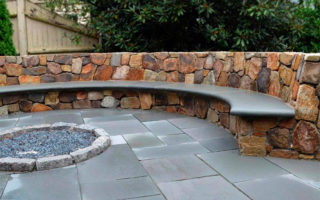
This material is used as a filler in screen fences. They take impact-resistant or tempered glass, thick enough. Glass can be transparent, matte, tinted. This model is very beautiful and practical, since the material is not afraid of water and weather factors. However, the installation of glass panels is rather complicated: they weigh a lot, require special fastening and, with high strength, are rather fragile.
Of stone
I make railings and balusters on the veranda from natural or artificial stone. For the street, a low-porosity material is required, like basalt, granite, porcelain stoneware. Marble or malachite is an unfortunate choice, since for all its beauty, the stone absorbs dirt.
Stone fences are extremely durable, long-lasting, and very beautiful. However, their installation is difficult, since the structure weighs a lot and requires high precision during operation.
Cellular polycarbonate or monolithic
A type of plastic with unique properties. Polycarbonate is transparent (98% of silicate), but at the same time it is 200 times stronger and practically unbreakable. He is afraid of the sun, so honeycomb and monolithic plates from it are coated with a special varnish. The plastic fence is not sensitive to other weather factors.
Polycarbonate does not let heat back through, so it is used for greenhouses. This disadvantage is irrelevant for outdoor terraces. But for closed verandas, you need to choose another option, otherwise it will be very hot here.
From ropes or ropes

Temporary fencing option. Ropes and cables are strong and lightweight, the weight of such a structure is very low. Stationary stone and metal racks or mobile ones are used as supports.
The main disadvantage: the softness of the fence. Children willingly use the ropes as ladders and swings, but a small child can crawl through the fence and end up in the garden unattended.
Made of wood
Wooden terrace railing is the most popular option. Wood is an affordable material, lightweight, environmentally friendly and very beautiful. Wood can be cut, sharpened, polished, carved, or burned onto the surface. The construction is carried out in any style - from rustic to high-tech, from luxurious baroque to techno.
Fences of a terrace or veranda made of wood are strong, durable, reliable. However, the material is quite sensitive to the action of water, heat and cold, therefore it needs protection.The wood is covered with paint or varnish, impregnated with wax or stains. Hardwood models - larch, oak - do not need protection.
Bamboo fencing is a very exotic solution for mid-latitudes, but quite justified from a practical point of view. Mature, thick stems are very durable and completely replace metal stands. Transverse and longitudinal elements are made from stem fragments, and soft processed fibers are used to weave screens.
Options by type of execution
From the point of view of construction, fences are divided according to the type of preferential elements. These will be support posts, transverse elements, screens.
Horizontal
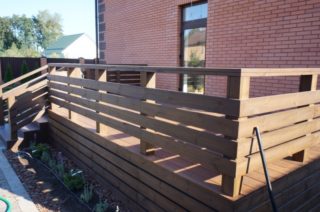
The filling is made up of horizontally placed strips. The support balusters are vertical, but they are hardly noticeable and are located at a great distance so as not to affect visual perception.
Horizontal fences are made of wood and metal. Used tree branches, bamboo, vine.
Vertical
The filling is made up only of vertical elements - both posts and filling strips. In fact, the railing for the veranda and terrace consists of only balusters. Standard solution for stone and concrete structures, PVC or plaster models.
Crossover
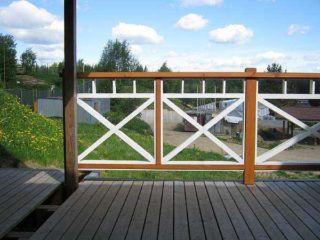
The lintels and filling strips intersect with each other, forming a kind of lattice. The pattern can be more complex. A fence is made of flat wooden planks.
Screen
The filling consists of a solid or perforated sheet - screen. This is a closed version, very reliable and secure. Screens are made of glass, polycarbonate, bamboo, and sometimes wood.
DIY terrace fences
Most often they make a wooden fence on their own. This material is much easier to process and much more affordable than stone or plaster. A beginner can handle the simplest option if the instructions are followed.
Step-by-step construction procedure:
- Choose a tree species: larch, spruce, pine, oak. Take hard rocks or resinous.
- Calculate the dimensions: on average, the fence must withstand at least 100 kg of load, so the thickness of the support posts and balusters must be sufficient. In accordance with SNiP, a height is chosen - at least 50 cm, the distance between the supports is at least 10 cm.
- Lay out the veranda. With high complexity, a drawing is made. It is recommended to place the supports slightly stepping back from the edge.
- The main supports are mounted first - at the corners and at a distance of up to 1.5 m from each other. They are more massive. Attached to studs or anchors. Holes are drilled in a wooden or concrete floor for fasteners.
- Balusters are fixed at a distance of 10-15 cm from each other. If installation is carried out on dowels or pins, holes are previously made for them. Self-tapping screws can be attached directly through the base of the baluster. But this method is not very reliable.
- In the railings, grooves are made for the ends of the balusters and they are installed on the finished sections.
To strengthen the structure, use metal corners, supports, guide strips.
Maintenance of terrace fences
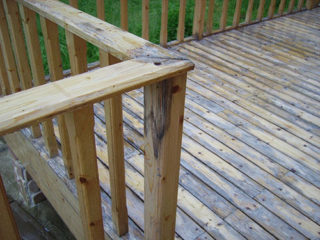
Care is required for any design, but depends on the material.
- Wooden fences must be varnished. It is recommended to treat the wood with antiseptics before construction, less often stains and wax are used, since such a coating should be frequently renewed.
- If the paint or varnish layer is damaged, the coating is immediately renewed.
- The metal railings on the veranda are also covered with enamels or nitro paints. Chrome plated models are simply cleaned.
- Stone, PVC models, polycarbonate screens should be washed periodically. Abrasive cleaning agents are not used.
Fences for terraces and verandas are made of wood, stone, concrete, metal, even glass. They are very diverse in configuration, structure, decor.The choice depends on the style of the building, material availability, financial capabilities and personal preferences.








